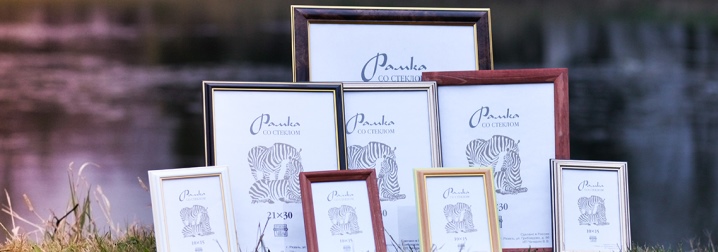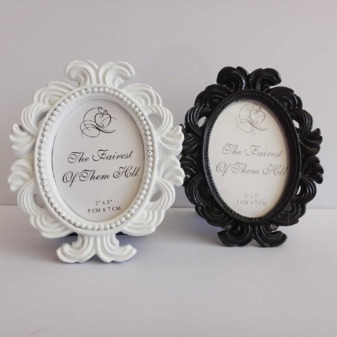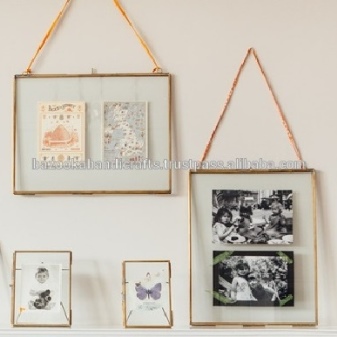Review and selection of sizes of photo frames

Even paintings have long ceased to be the subject of unprecedented chic and have filled home interiors, and good photographs can be seen on the wall in almost every home.
For beauty and additional protection, the photo is framed, but it is necessary to choose such products wisely, being sure that it will fit the size of its "filling".


What are the standard sizes?
At one time, artists cut the canvas as they please. With the advent of photography, the situation did not change immediately - in the first decades after the creation of the first camera, manufacturers actively experimented with the shape and size of the frame itself. (a fragment of a film), and the printed result. In those days, one could only dream of any standard of photo frames, and each of them had to be ordered separately from the master, which made the pleasure, which was so expensive in those days, even more expensive.
Over time, manufacturers realized that it is much cheaper and more profitable to put the production of film and print photos on stream, and for this it is necessary to unify the parameters for the frame, photo and photo frame. It is naive to think that absolutely all manufacturers have the same standards, however, in an absolutely overwhelming number of cases, choosing a frame for attaching a photo to a wall will not be difficult - for sure it is printed in one of the most popular formats, which you yourself have chosen.


Most likely, your frame was printed in one of the following formats.
- AT 7. For photography, this format is most typical - the famous 9 x 13 cm. Nevertheless, these are more landscape dimensions - the image will look too small on the wall, details will be lost, because such small frames are rarely seen.
- A6. The second most popular photo standard is 10 by 15 cm, a quarter of the classic A4. Albums are often made for it, but the A6 is already well suited for desktop frames.
- AT 6. Perhaps the largest of the most common versions of classic photography - 13 by 18 will be printed in any photo studio. For placement on the wall, this is the very thing - there are quite a lot of such frames, and the size of the frame is sufficient to examine the details from a distance.
- A5. This size is largely due to the fact that most modern printers work with the well-known A4 format. Accordingly, A5 is half of it, and many people are interested in frames of such dimensions if they themselves print photographs of a house two per page. There are variations of photo frames 15 by 20 centimeters (a typical wall choice) and 15 by 21 (these are often desktop solutions with a back stand).
- A4. Since someone prints a photo two pieces per page, there must be someone who will not regret the paint on a whole sheet, if only the details are clearly visible. It should be noted that frames of this size are very widespread due to the fact that many documents worthy of demonstration are printed on home printers in full sheet - for example, thanks, certificates, diplomas and letters. As in the case of the A5, in fact, we are talking about two very similar standards at once - 20 by 30 and 21 by 30.

Non-standard formats
Finding a frame of any of the above dimensions is not difficult - even if for some reason there is no product of the required format at the nearest point selling photo frames, you will surely find it in the next place. Another thing is that all the most popular standards are strictly rectangles, with proportions of about two to three. To some of the creative people who want to give the interior some charm or originality, this will seem too boring and banal, because if necessary, even a rectangular photo at home can be cropped so that it takes on an atypical shape.
With non-standard photo frames or products of not the most popular standard sizes, it will be a little more difficult - in the modern world it is already easier to order them on the Internet than to find them at a regular outlet.


If we talk about rectangular options that we did not consider above, then there are quite a few of them. In most cases, they imitate popular paper and cardboard sheet sizes - for example, A3 (30 by 40), A2 (40 by 50 or even 60), A1 (60 by 80) or A0 (80 by 120). These are, respectively, 2, 4, 8 and 16 A4 sheets familiar to us. Due to the popularity of paper of the corresponding size, similar photo frames are relatively popular, although they are more often used not for photos, but for posters and paintings.


Roughly the same logic is relevant for standards with the letter B in the title - decreasing the number by one means doubling the frame size. The B4 format in the 24 by 30 version is considered the largest of the desktop ones with a back leg - everything that is larger is a priori hung on the wall.
Standards of category B4 and higher are relatively rarely in demand, they are most often used for decorating landscape photographs.


In addition to A and B, there is another, relatively rare group of standards in proportions of two to three - SRA. By the numbers denoting the size number, this size is something between A and B. So, SRA3 is 30 by 45 centimeters, and SRA0 is 90 by 120. If the rectangular shape is generally perceived as banal, you can pay attention to where more rare square solutions. Due to the correctness of the figure, such a solution can give special aesthetic sensations, but it will be more difficult to fit the photo into the interior.


A separate topic is round (also known as rondo) and oval photo frames. This type of product is almost always used to decorate a portrait.
The very fact that a photo has no corners will cause viewers to associate it with something vintage, so it makes sense to choose a frame with an imitation of an antique frame, and choose a photo that imitates the traditions of photography of the past decades.


How to choose?
The main thing when choosing a photo frame is to know the size of the photo so that you do not have to crop the image and there is no free space within the frame. You can find out the dimensions of the photo at home using an ordinary ruler. Then it remains only to compare the obtained figures with popular standards and inform the seller in the store (or an Internet search engine) the name of the standard size.
Frames come with and without glass, and although you can choose any to your taste, usually only products with glass are called a photo frame. - the latter helps to extend the life of the photo and protect it from accidental mechanical stress.


In this case, the glass is different, and it must also be chosen correctly. Here are the options available:
- polished silicate - very transparent, without inclusions, does not distort the picture at all, but has too high reflectivity, which is why it is inappropriate in rooms with bright lighting, especially for dark photos;
- matte anti-reflective - due to the rough surface, it does not glare, but the same roughness introduces some distortions both in the contours and in the color rendition, giving the picture an unnecessary whitishness, like in some glasses;
- museum antiglare - combines the best features of the two solutions described above, does not glare and does not affect the free passage of light, received the title of "invisible" for its qualities, but it is expensive.


The material of the baguettes, which the frame is framed with, is important for the holistic perception of the photograph.
Wood is good for its versatility - inside which frames you can insert anything and in any style, but the cost of the wood product bites if cheaper chip materials were not used. Plastic is good in the sense that it costs a penny, but it is able to naturally imitate any other materials, including the same wood. Metal is the best choice for connoisseurs of minimalism, glass is ideal for futuristic designs.

For information on how to make a photo frame with your own hands, see the next video.













The comment was sent successfully.